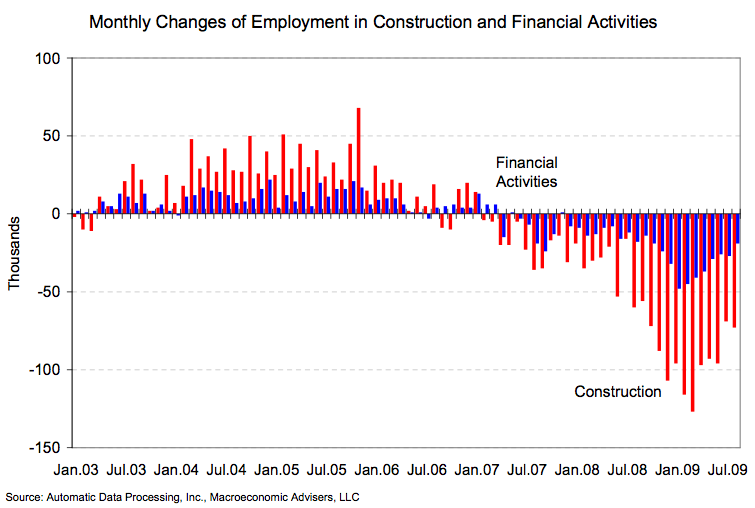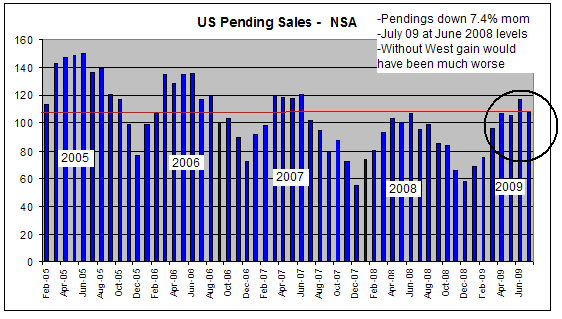Despite the cheerleaders best efforts, the latest set of data to come out is filled with signs that the recovery — when it finally arrives — will be unimpressive. The best word for it is probably “sluggish.”
My belief has been the government stimulus, cash for clunkers, and first time buyers tax credit has partly obscured the ongoing weakness, making it appear better than it really is. As these programs sunset, what is left behind is a wounded economy, healing very slowly.
Employment: I am not a huge fan of the ADP Report — its useful for trend only, but its precision and accuracy is somewhat wanting. However, the downside surprise this morning lends evidence that we will not see a notable improvement in NFP on Friday.
“Companies eliminated more jobs than forecast in August, a private survey indicated today, signaling that employers have yet to gain confidence about a recovery from the deepest recession since the 1930s.
The 298,000 drop followed a revised 360,000 decline the prior month that was smaller than previously estimated, according to figures from ADP Employer Services.”
Retail Sales: No money, no sales. With hiring soft, wage gains flat, and various costs of living like health care and education seemingly immune to deflation, the consumer is pinched. (Don’t blame me, I am doing my part).
WSJ:
“Shoppers are focusing on deals and limiting buying mainly to necessities, based on August sales estimates that herald another tough holiday season for beleaguered retailers.
Despite sales tax holidays in several states designed to spur sales, back-to-school spending remains lackluster, according to industry experts. Retailers’ recent efforts to shake customers from deep discounts and spur buying by tightly controlling inventories are fizzling.”
Housing: I have long argued that against reading seasonality as an improvement in real estate, yet that was exactly what we got in the recent string of NAR data.
The”annualization of seasonality,” as Mark Hanson calls it, completely misstates the reality of the housing market. Hansin notes that on a “real” — not-seasonally adjusted basis — the national pending sales fell out of bed: It was down 7.4% m-o-m.
The Northeast plunged 20.9%, Midwest 15.2% and South 5.6%. The West was up 7.9%, which was likely due to end of the $10k New Home tax credit I highlighted over the weekend. In addition, the West had been lagging other regions so part of the jump could be end of the season buyers just ‘going for it’. The drop in the Northeast was startling — perhaps this will result in fewer condo sales in the region in the next existing sales report.”
And that’s before we even get to the issue of commercial real estate, as detailed in this mornings NYT:
“Even though industry lobbyists were able to persuade Congress to extend a loan program aimed at prodding the stalled securitization market back to life, several analysts said it was unlikely to head off a spate of defaults, foreclosures and bankruptcies that could surpass the devastating real estate crash of the early 1990s. “It will prop up a few deals, but you can’t stop the wave that’s coming,” said Peter Hauspurg, the chief executive of Eastern Consolidated, a New York brokerage firm.
The distress is still in its early stages, analysts said. “We are between the first and second inning,” said Richard Parkus, who directs research on commercial mortgage-backed securities for Deutsche Bank. “We’re going to have to get through a very difficult period.”
Finally, the ISM was a more positive datapoint, but it is essentially a survey (diffusion index) and not an actual measure of production, sales or hiring.
~~~
The bottom line is that this not a healthy situation, and it is not likely one that is on the verge of snapping back anytime soon.
Regardless of the “message of the market” — a 50% rally from deeply oversold conditions is not the same as an improvement in Hiring, Sales, Income, Industrial Production or Housing.
Beware those who tell you it is . . .




What's been said:
Discussions found on the web: